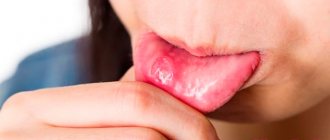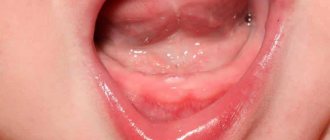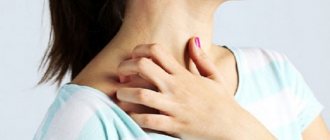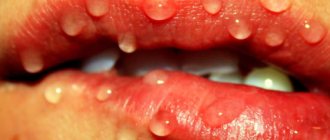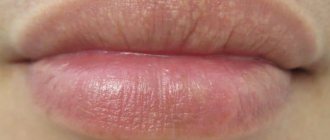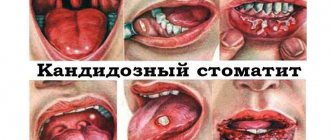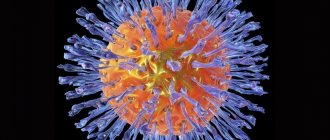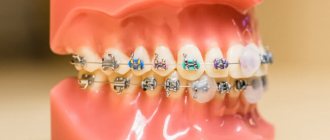A person’s appearance is the first thing that people around him pay attention to. Irritation on the lips and allergic reactions on the face create a repulsive impression. Rashes and other visual defects on the lips develop in both adults and children.
The disease brings a person not only painful and unpleasant sensations, but can also cause serious harm to health. It is important to correctly recognize the first symptoms in order to promptly begin treatment for lip allergies. This will reduce the risk of complications and also speed up the healing process.
What are the types of rashes on the lips?
There are several types of negative reactions that are localized in the lip area. The patient’s further treatment depends on their type and causes of occurrence. Therefore, it is better to correctly recognize a rash on the lips at the initial stage. It comes in the following varieties:
- Redness of the lips in the form of rashes on their entire surface. In this way, the body signals the onset of an allergy on the lips of an adult or child to a certain food product or medication. If you do not take any action, red dots will appear on your lips, which will begin to rapidly spread throughout your body. The next symptom is itching on the lips.
- Rash on the surface of the lips in the form of semolina. A sign that the human body’s protective functions have deteriorated. They do not cope with their tasks fully. Rashes in the form of semolina indicate that the body has problems with the functioning of the gastrointestinal tract, as well as diseases of viral origin. It is better not to start treatment on your own. At the first symptoms, you need to contact a dermatologist so that the doctor can accurately determine the causes of the disease and prescribe the optimal treatment time. If a white rash begins to appear on the lips and mouth of an infant, this is the first sign of the development of thrush.
- Bubbles filled with clear liquid began to form on the lips. This is a symptom of herpes. It usually appears in a person at a time when the immune system weakens or has completely failed. In this case, it is necessary to undergo a full course of treatment.
- The rash appeared on the inside of the lips. Typically, a symptom is not a warning of the onset of an allergic or other negative reaction. A rash on the lips could appear as a result of mechanical damage, impact, or ingestion of solid foods. In the place where the integrity of the tissue has been violated, a bubble forms. After a while it will burst. To prevent infection from getting into the wound, you must follow all the rules of personal hygiene. It is better not to touch the damaged area and be sure to rinse your mouth after eating.
- A small rash on the lips in the corners of the mouth. It is usually caused by failure to comply with personal hygiene rules. If a person does not wash fruits and vegetables before eating, then dirt and bacteria can accumulate in the corners of the lips, which can cause rashes or irritation.
When too much of an allergen enters the human body, there is a high probability of developing Quincke's edema or anaphylactic shock . To quickly relieve signs of allergies and prevent complications from developing, you must urgently take an antihistamine and also undergo an examination by a qualified specialist.
If a person notices a rash on the lips and does not know what to do or what to take as a cure, he should immediately seek qualified medical help. After the examination, the doctor will determine the cause of the rash and select the optimal course of treatment for the patient.
Treatment
To prescribe treatment, you must consult an allergist. Self-treatment can lead to a chronic process, which will be difficult to get rid of in the future. Before therapeutic procedures, the doctor identifies the allergenic factor and carries out a differential diagnosis with other similar pathologies.
Specific immunological tests allow you to determine the allergenic irritant. This is necessary for successful treatment, since the therapeutic effect will not occur with further exposure to the allergic factor.
Medicines
Treatment of allergies on the lips begins with taking tablet forms of antihistamines - Suprastin, Tavegil, Loratadine. The active substance of the antiallergic action binds histamine and blocks its desensitizing effect. If the allergy on the lips is severe, antiallergic drugs are administered by injection.
Steroid hormones (Prednisolone) are injected into a vein during first aid in a hospital or by emergency doctors. Glucocorticosteroids will prevent swelling and neutralize the allergenic irritant.
Cleansing of the entire body is carried out using adsorbents. Some of the commonly used drugs are activated carbon, Polysorb, Enterosgel. Fenistil and vitamin E in liquid form are suitable for topical use on the lips.
Folk remedies
To remove cracks on your lips and prevent dry skin, you can use folk recipes:
- Aloe has long been known for its moisturizing and healing abilities. A few drops of freshly squeezed juice can be used to effectively wipe your lips to prevent the skin from drying out and cracking.
- Jojoba or sea buckthorn cosmetic oil is suitable for restoring the delicate skin of the lips; this method is especially good if you are allergic to lipstick.
- At home, you can make a healing ointment: mix a little zinc ointment with liquid fish oil. Apply to lips at night until complete recovery.
- Finely chop fresh plantain leaves and mash until smooth. Apply to affected areas for 20 minutes, then rinse with warm water.
Symptoms
Rashes on the lips can indicate not only the beginning of the development of an allergic reaction, but also the entry of bacteria and viruses into the body. The sign also indicates autoimmune diseases. Therefore, before starting treatment, you need to make a correct diagnosis.
The rash is localized in different parts of the mouth. Based on the place of its formation, the disease can be established. Among them:
- cheilitis. It forms on the mucous membrane of the lips. Cheilitis develops in the form of a rash;
- glossitis. Eczema on the lips spreads to the tongue area;
- gingivitis. Gum affected area;
- stomatitis. Inflammations on the lips appear on the mucous membrane of the oral cavity;
- palatinite. Various types of rashes form in the palate area;
- papillitis The location is on the gum papillae;
- psoriasis on the lips.
When inflammation on the lips and in the oral cavity is allergic in nature, they can be divided according to severity. Each of them has its own main symptoms and distinctive features.
- Catarrhal. It is characterized by moderate symptoms, which include: dry mouth, unpleasant and painful sensations while eating, burning and itching.
- Hemorrhagic. Small spots begin to appear. They resemble small hemorrhages that form on the mucous membrane.
- Bullous. This stage is characterized by the appearance of bubbles. If their integrity is compromised, this can lead to the formation of erosions.
- Ulcerative-necrotic. Ulcers with necrosis appear on the mucous membrane of the oral area. They give a person unpleasant painful sensations. If measures are not taken in a timely manner, serious complications may occur, resulting in damage to the lymph nodes. This will lead to poisoning of the body as a whole.
- Erosive. It is characterized by the formation of erosions, which are accompanied by pain.
The development of lip allergies is accompanied by the following symptoms:
- dryness of the tongue and mucous membranes;
- the presence of an unpleasant aftertaste;
- the presence of a small rash or blisters in the mouth;
- if the allergic reaction becomes more severe or chronic, ulcers may appear in the mouth;
- the appearance of severe itching;
- in general, a person feels discomfort, which may be accompanied by pain.
If swelling appears on the lip due to allergies in children, then it is much more severe than in adults. It is characterized by a more acute onset, which is complemented by general intoxication of the body. This occurs as a result of the fact that the child has a much weaker immune system, but metabolic processes occur faster. This causes difficulties in making a correct diagnosis in the early stages. In some cases, doctors discover an allergy only when it begins to cause complications on the child’s body.
Diagnosis of the disease
If allergy symptoms occur on sponges, you should consult a specialist.
Diagnosing this disease in some cases is not an easy task. This is explained by the fact that the symptoms of sponge allergies can be confused with the symptoms of other diseases that are infectious in nature.
In order to diagnose an allergy to sponges, the patient is prescribed a skin patch test and a patch test from the oral mucosa; the results of the tests will be known to the patient within a day.
These research methods will allow you to find an irritant that will have a bad effect on the patient’s body.
Inflammations on the mucous membrane appear not only as a result of the action of various irritants on them, but also due to the action of organisms such as yeast fungi or pathogenic bacteria.
It is very common for patients to confuse oral allergies with other diseases when making a diagnosis.
This leads to ineffective treatment of the disease.
When the first symptoms of this disease appear, you should not make a diagnosis without the help of others. This is explained by the fact that as a result of incorrect healing, the disease will quickly develop, which will lead to bad consequences.
Reasons for the development of allergic reactions on the lips
There are several common diseases that can cause eczema on the lips. Let's look at each of them in more detail.
Dermatitis on the lips
Dermatitis is characterized by symptoms such as:
- a strip of white skin that is localized around the lip;
- lips turn red;
- itching;
- burning;
- redness of the skin;
- swelling of the upper and lower lips, which leads to severe swelling.
The disease is more common in women over 40 years of age. Dermatitis on the lips is formed as a result of a malfunction or disruption of the proper functioning of the gastrointestinal tract, as well as taking medications that contain hormones.
Dermatitis on the face
Allergic reaction
For allergic reactions, the rash is small in size. They form on the surface of the lips. The person feels itching and discomfort. He may begin to experience swelling of the larynx, which is one of the most obvious signs of the development of an allergy. The main cause of a negative reaction is close contact of the allergen with human skin. These substances include: cosmetics, eau de toilette or perfume, toothpaste or mouthwash.
Allergic reaction on and around the lips in an adult
If you do not take medicine in a timely manner, the action of which is aimed at eliminating the allergy, the reaction will begin to spread further throughout the body. First it will be the face and neck, and then the lip allergy will move to the upper body.
Fordyce disease
Eczema on the lips appears in the form of specific white granules. They begin to form above the upper lip. This occurs as a result of disruption of the hormonal system, which leads to the expansion of the sebaceous glands in this part of the face. Typically, the disease is typical for girls and boys during puberty, as well as for pregnant women in the 1st trimester. It does not give a person a feeling of pain or discomfort, so it does not bother him much. The disease can go away on its own after hormonal levels normalize, or with the help of local therapy.
Whitish rash on the upper lip due to Fordyce disease
Herpes
Herpes is of a viral nature, which is characterized by the formation of specific blisters on the lips. They are filled with liquid inside. It can be transparent or grayish in color. Bubbles appear above the upper lip or in the corners of the mouth. If a person has herpes in his body, then it is no longer possible to get rid of it. The pathology is transmitted from mother to child, sexually or in cases of decreased protective functions of the body.
Herpetic manifestations on the lower lip
These reasons are the main prerequisites for the appearance of a rash. In addition to them, there are several additional factors that provoke the appearance of this symptom, which is unpleasant for a person. These include:
- long-term use of medications to which a person develops side effects;
- presence of bad habits. This is especially true for smoking and alcohol abuse;
- use of low-quality cosmetics. For example, creams, lipsticks, glosses and even coconut oil;
- weakening of the body’s protective functions as a result of the development of acute respiratory infections and acute respiratory viral infections.
Also, allergies and rashes on the lip develop in a person due to non-compliance with personal hygiene rules. As a result, the pores become clogged and are unable to perform their functions.
Classification
Lip allergies can be an acute condition when symptoms appear suddenly and are severe. With adequate treatment, the manifestations quickly pass and do not return if the allergenic factor has been eliminated. If sufficient measures are not taken, allergies can last a long time, turning into a chronic process.
Types of cheilitis:
- Exfoliative is a type of allergic reaction, the cause of which is nervous disorders, depressed mental state, inhibited immune reactions, genetic predisposition. It appears in the form of deep cracks on hyperemic lips, itching and severe peeling appear along the perimeter of the lips.
- Contact allergies occur when allergenic irritants come into contact with the skin when touched. This form most often affects children during puberty, when changes in hormonal levels cause a decrease in immunity and a malfunction in metabolic processes. Lip glosses, toothpastes, and braces can be irritants. The skin becomes dry and flaky; manifestations are possible not only on the lips, but also on the skin around them within a radius of two centimeters.
- Cheilitis caused by weather conditions - meteorological allergies can develop after ultraviolet radiation, exposure to frost or strong wind. The lips are dehydrated, the skin shrinks into numerous folds, the color of the pigment becomes pale, peeling and red spots are possible. One of the most dangerous forms, when it enters the chronic stage, it causes serious consequences.
- Glandular - associated with damage and blockage of the minor salivary glands. Provoking factors are dental caries, the presence of periodontal disease, and foci of chronic infection. This type of allergy appears due to inflammation of the salivary glands, stenosis of the gland's tubules, and infectious lesions. A characteristic manifestation is swelling of the lips.
- Atopic cheilitis - this pathology affects people with food allergies, which are aggravated by pathologies of the intestines and stomach. The lips become very dry with small flaky particles. The color is bright red, and not only itching, but also slight pain may occur.
- Macrocheilitis is a severe form of allergic pathology that is rare. The nature of origin is hereditary, the condition develops after previous infections. Macrocheilitis usually occurs simultaneously with facial paralysis. Allergic swelling of the lips is the main symptom of the disease, accompanied by cracking and may not go away for several months.
- Cheilitis due to vitamin deficiency - an insufficient amount of vitamins and microelements can lead to the following manifestations: lips itch, painful cracks (jams) appear in the corners of the lips, which become covered with yellow crusts. The condition is complicated by the possible addition of a pustular infection and constant irritation when opening the mouth.
Diagnostic measures
A rash on the lips is treated by a dermatologist. There can be a large number of reasons for the development of pathology. To prescribe optimal treatment for a patient, the doctor must first conduct a comprehensive examination. This will help determine the true cause of the pathology problem. Only after this should therapeutic measures be prescribed.
The examination includes:
- Tests performed on the skin. A skin test is carried out to identify the allergen that provoked a negative reaction in the body.
- Taking blood for analysis. Based on its results, the specialist will be able to see a complete picture of what is happening inside the human body.
- Immunogram. It helps the dermatologist to correctly assess the state of the immune system.
If the doctor’s research is not enough to establish the cause of the allergic rash, then he can additionally prescribe the patient to undergo an ultrasound of the internal organs, do a cardiogram of the heart, and also visit other specialists for examination.
Causes
The most common causes of lip allergies include:
- reduced immune defense of the body due to chronic diseases and deteriorated environmental conditions;
- the reasons for the frequent development of cheilitis may depend on hereditary predisposition;
- often long-term antibiotic therapy and hormonal medications lead to the occurrence of allergic manifestations on the lips;
- Weather phenomena (cold, wind, ultraviolet rays) are of no small importance;
- a common cause of lip allergies is the presence of chemical elements in cosmetics and personal care products;
- Quite often children are brought to an allergist who have a contact type of disease on their lips after playing with their mother’s cosmetics;
- in addition, quite often there is a negative reaction to new dentures for teeth made of plastic;
- a rash can appear even on dental powder and toothpaste;
- The causes of the disease may be hidden behind professional activities that are associated with harmful effects.
However, most often allergic symptoms develop to food allergens, so it is important for patients to follow a hypoallergenic diet, excluding the most harmful foods.
How is a rash on the lips treated?
To get rid of pathology, you need to influence not only the visual manifestations of the disease in the form of rashes, but also begin to eradicate the problem from within the body. Having removed the cause of the allergy, the rash on the lips will go away on its own in a short period of time.
Drugs
Medications can only be prescribed by a qualified specialist. He must take into account the course of the disease, the reasons that caused it, and also take into account the individual characteristics of the body. To treat rashes on the lips, the following are used:
- local ointments. They are used for the treatment of herpetic eruptions;
- antihistamines and ointments that contain hormones. They will help you quickly cope with allergic manifestations;
- antibiotics. Medicines help to get rid of oral dermatitis as quickly as possible.
Special attention should be paid to therapeutic measures for thrush in infants. To ensure that it leaves the child’s body, sodium tetraborate or a solution of baking soda is used. These products should be used to treat red lips and tongue in a child.
Traditional therapy
To quickly relieve symptoms or prevent the rash from spreading throughout the face, you can use some recipes from traditional medicine. Among them:
- Mumiyo. Take 1 tablet and dilute it in water. It is enough to add 1 drop of natural honey to the resulting solution so that the result does not take long to arrive. The product is carefully applied to the affected skin of the lips and left there for 10 minutes. Repeat several times a day. If a person is allergic to honey, then it should be replaced with fir oil.
- Calendula. You can prepare the most common tincture from it. Wipe the affected area to relieve the person of severe itching and burning of the skin.
- Ice. Frozen water will help reduce the number and growth of herpes blisters. The product also fights well against the causes of swollen lips on the face.
Traditional recipes can only be used as additional means of treating rashes in the lip area. If the pathology does not decrease, but, on the contrary, begins to spread across the face, you should immediately stop using this treatment method and consult a qualified doctor.
Treatment of allergic cheilitis
The main therapeutic step for inflammation of the lips is diagnosis, which is carried out at a doctor’s appointment. The procedure allows you to determine the nature of the disease, the presence or absence of an allergic nature. The second equally important point is the selection of the drug.
Diagnostics
Diagnosis takes into account the history and clinical manifestations. At the same time, it is important to recognize allergic cheilitis and not confuse it with its other varieties. Identifying the cause of the allergy and the irritant plays a major role.
The fundamental point is an indication of recent interaction with the allergen. If before the inflammatory process the patient used lipstick or purchased a new product or visited a salon, then the reason lies precisely in that product.
If no changes have occurred (there has been no use of new cosmetics or toothpaste, no procedures), then they use the method of elimination. Gradually remove one product at a time that the person used as usual. Traditionally, allergen tests are performed to determine the irritant that caused the reaction.
Sometimes allergies on the lips are accompanied by stomatitis and herpes. Treatment in such cases is aimed at suppressing the infection. At the same time, antihistamines are taken orally. The same principle is used to treat cheilitis and allergic dermatitis. Ointments are used and anti-allergy tablets are used.
Important! If a child has an allergy on his lips, contact a pediatrician. Adult patients - see an allergist or dentist.
Review of antiallergic drugs
The treatment regimen consists of using ointments based on corticosteroids and antihistamine tablets. The latter block histamine receptors, as a result of which the release into the blood of substances that form the development of allergies is suspended. During treatment, products that irritate the skin of the lips are excluded. Apply and rinse with chamomile infusion and Rotokan.
The list of antiallergic medications for the treatment of contact cheilitis includes the following drugs:
- Claritin is a classic version of an antiallergic drug. Belongs to the 2nd generation of antihistamines, characterized by high activity. The active ingredient is loratadine. The medicine is characterized by antipruritic, antiedematous, antiexudative effects. The effect occurs within half an hour and lasts a whole day.
- Cetrilev - belongs to the 2nd generation of antiallergic drugs. The active ingredient is cetirizine. Prevents the development and facilitates the course of the allergic process. Suitable for children over 6 years old.
- Cetrilev-gel - a cosmetic gel is used as an additional treatment for cheilitis, dermatitis, and urticaria. The product reduces swelling and itching, inflammation, and prevents the production of antibodies. Allowed for children from 3 years old. Active composition: extracts of basil, string, walnut, calendula, lavender oil, cloves, sulfur, menthol, panthenol, vitamin F.
- Fexofen is a 3rd generation drug. The active ingredient is fexofenadine. Does not have cardiotoxic properties.
- Rupafin is an antihistamine that affects the early and late phases of inflammation. The active ingredient is rupatadine. Suitable for symptomatic use.
- Cortiderm is a corticosteroid ointment based on hydrocortisone. The product has antipruritic, anti-inflammatory, anti-edematous effects. Apply with rubbing movements or apply compresses. Available in 10, 15, 30 g tubes. Used as prescribed by a doctor.
- Rotocan is an additional remedy for the treatment of inflammatory processes on the lips. Shows wound healing and anti-inflammatory properties. The drug contains extracts of chamomile, yarrow, and calendula. The liquid extract is available in 55 ml containers.
- Pimafucort is a combination drug based on antibiotics and corticosteroids. Suitable for the treatment of dermatitis, urticaria on the lips. The ointment relieves inflammation, reduces itching, and kills bacteria. Used for short-term treatment of dermatitis. Available in 15 g tubes.
- Fenistil-gel is an ointment for external use against allergies, suitable for lips. Reduces itching and irritation, eliminates itching, inflammation, and signs of an allergic reaction. The active ingredient is dimethindene. Used for reactions to insect bites, sunburn and allergic lesions. Available in tubes of 30 g.
- Ketocin - refers to antiallergic ointments for local therapy. It has antiseptic, antipruritic, anti-inflammatory and antihistamine effects. Active composition: ketotifen, boric acid, zinc oxide, dimethyl sulfoxide. Unlike corticosteroid topical agents, the ointment does not inhibit the regeneration processes of the epidermis. Available in containers of 30 and 40g. Avoid contact with mucous membranes.
- Sea buckthorn oil – has a slight antibacterial effect, stimulates healing, softens the skin. Used in the form of compresses. Available in 50 ml containers.
Allergy on lips: how to treat?
When an allergy occurs on the lips, the patient takes antihistamines. Histamine is produced by the body and provokes an allergic reaction.
Allergy-blocking drugs (Claritin, Suprastin, Eden) are recommended. If this disease occurs, it is better to consult a doctor. The medical institution will conduct allergen tests to determine the cause of the allergy. The doctor will name the allergen. This information will help you avoid contact with the allergen.
The doctor may prescribe hormonal gels and ointments (Fluorocort, Flucinar). It is dangerous to use hormonal drugs for treatment without a doctor’s prescription - there are mucous membranes nearby. Antihistamines can be carried with you to provide first aid if necessary.
If your lips are swollen due to an allergy, lotions and ointments can relieve the unpleasant symptoms. So, compresses will relieve the feeling of dry lips. You can moisturize your lips with hygienic lipsticks. You should not lick your lips - the skin on your lips will become even drier. Compresses prescribed by your doctor will help with itching.
Possible complications
Different causes of allergies cause different kinds of complications. Their nature lies in special factors. Thus, advanced swelling during herpes can provoke neoplasms in the same place. This will lead to an unaesthetic appearance and unpleasant sensations.
If there was any damage to the lips, this will be the beginning of inflammatory processes. Abscesses form in this area. After these manifestations pass, scars will remain on the skin.
Neglect of lip swelling can result in irreversible consequences. Sometimes the outcome can be fatal. You can’t waste time and put off going to the doctor. Only a competent specialist will conduct a high-quality examination and prescribe a number of measures to eliminate swelling.
Allergy on lips: how to treat?
When an allergy occurs on the lips, the patient takes antihistamines. Histamine is produced by the body and provokes an allergic reaction.
Allergy-blocking drugs (Claritin, Suprastin, Eden) are recommended. If this disease occurs, it is better to consult a doctor. The medical institution will conduct allergen tests to determine the cause of the allergy. The doctor will name the allergen. This information will help you avoid contact with the allergen.
The doctor may prescribe hormonal gels and ointments (Fluorocort, Flucinar). It is dangerous to use hormonal drugs for treatment without a doctor’s prescription - there are mucous membranes nearby. Antihistamines can be carried with you to provide first aid if necessary.
If your lips are swollen due to an allergy, lotions and ointments can relieve the unpleasant symptoms. So, compresses will relieve the feeling of dry lips. You can moisturize your lips with hygienic lipsticks. You should not lick your lips - the skin on your lips will become even drier. Compresses prescribed by your doctor will help with itching.
Why can swelling develop with urticaria?
What does angioedema look like? The basis of any allergic reaction, including urticaria, is the immune response to the penetration of all kinds of irritating and foreign substances into the human body. At the very first contact with this factor, only increased susceptibility to it develops, that is, the body remembers, but practically does not react clinically at all. But in the case of all subsequent contacts, a response in the form of an allergy always develops.
All symptoms that appear with urticaria occur under the influence of histamine, which is produced almost instantly after the penetration of the allergen.
As a result of the synthesis of histamine, the vascular permeability of the skin increases, which leads to the formation of redness and swelling.
Angioedema with urticaria occurs when the process spreads deep into the tissue, into the subcutaneous tissue, affecting the mucous membranes.
Urticaria and angioedema can occur not only in the face and larynx, which is most often diagnosed, but also in the lower leg, chest, internal organs, and genitals. But, nevertheless, angioedema with damage to the mucous membrane of the larynx is considered the most life-threatening.
Treatment of angioedema
Treatment of this pathology must be carried out in a very short time in order to relieve an attack of an allergic reaction. It is almost always necessary to admit the patient to a hospital department. This is due to the fact that even if it was possible to quickly relieve inflammation, this does not mean that it cannot arise again after some time, especially in cases of an undetected reagent.
Urticaria and angioedema require the following treatment:
- Mandatory exclusion of the suspected provoking factor.
- Antihistamines help relieve the first signs of edema.
- If necessary, treatment with hormonal drugs (Prednisolone) is prescribed.
- Treatment with Enterosorbents is also necessary, which helps remove the allergen from the body faster.
- It is advisable to carry out detoxification therapy in combination with diuretics.
- A good effect is achieved by prescribing hyposensitizing drugs (Sodium Thiosulfate)
Treatment of this pathology is simply impossible without following a hypoallergenic diet, since cross-reactions can quite often occur. It is also important to drink plenty of fluids to remove all irritants as quickly as possible and thereby relieve swelling.
Angioedema can often be very severe, requiring its treatment in intensive care units.
